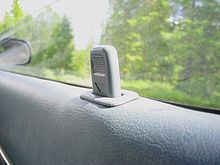Door lock
A door lock is a control element in a car with which the doors can be locked and unlocked from the inside without using a key . The door lock is usually located in the interior door panel of the car.
Executions
- The version installed in most vehicles so far is the so-called door pin or door knob . It is cylindrical or mushroom-shaped , protrudes from the window edge of the door panel and can be pushed in (locked) or pulled out (unlocked). In some vehicles such as the Peugeot 404 and Wartburg 353W , these functions are reversed.
- A disadvantage of this design is the poor anti-theft protection, poor ergonomics and, in older vehicles, the risk of injury from the door knobs in an accident.
- Ford and some Japanese and French manufacturers have therefore switched to combining the door lock with the door opener in a combination element. The lock is usually found here above the door opener and the door can be locked by pushing it inwards or unlocking it outwards. In some vehicles, the door can also be locked by pushing in the door opener.
- Since the 2010s, many vehicles with central locking no longer have a visible door lock. The central locking is then operated from the inside via a switch ( VW Touran , Renault Clio ). When the vehicle is locked, this is often indicated by a red flashing light-emitting diode in the door panel.
symbolism
With some manufacturers, such as Opel , Honda and Toyota , the locks have a red marking on the inside, which should warn of an unlocked door. In contrast, on some of its earlier models , Ford used a white mark to indicate that the door is locked.
Door knobs in the shape of skulls are particularly popular in the Gothic and American custom car scenes .
literature
- Hans-Hermann Braess, Ulrich Seiffert: Vieweg manual automotive technology. 2nd edition, Friedrich Vieweg & Sohn Verlagsgesellschaft mbH, Braunschweig / Wiesbaden 2001, ISBN 3-528-13114-4

